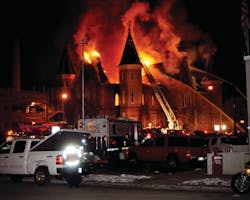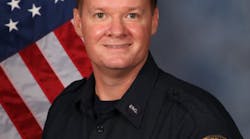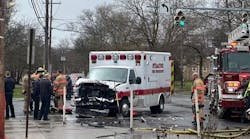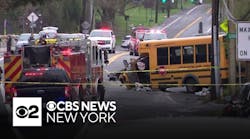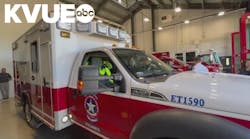On Friday, Dec. 17, 2010, a two-alarm fire destroyed the Provo Latter-Day Saints Tabernacle, considered a “historic treasure,” in Provo, UT. Investigators determined the fire was unintentional and likely was caused by a heat source placed too close to combustible materials. The loss was estimated at $15 million.
Construction of the 1,500-seat Tabernacle, listed on the National Register of Historic Places, began in 1883 and was completed in 1886 at a cost of $100,000. It was dedicated on Dec. 8, 1898. The 16,228-square-foot building was constructed of unreinforced brick, five wythes deep, with a roof structure consisting of up to 10 rough-cut, two-by-12-inch planks held together with iron bolts. The roof deck was one-by-eight-inch planking and plywood with cedar shakes. The floor was one-inch, tongue-in-groove planks on top of two-by-12-inch, rough-cut floor joists. A balcony lined the north, east, and south interior walls and was supported by two-by-12-inch, rough-cut joists inserted into the masonry walls and 18 iron columns. Stairway access to the balconies was in octagonal turrets at each of the four corners of the structure. The ceiling deck consisted of lath and plaster on the interior ceiling supported by two-by-eight-inch joists topped with a plywood deck.
The building originally had a 147-foot-high clock tower in the center, but it was removed in the 1950s due to structural concerns. Numerous renovations were made to the facility in the 1980s and 1990s. A local fire detection system was installed in 1985, but was not monitored off site. The system consisted of smoke detectors in the attic, turrets, east and west lobbies and crawl space. The system was controlled in the west lobby. According to the building coordinator and members of the Facilities Maintenance group, the system had a history of false alarms, up to twice per month, but Provo Fire and Rescue had responded to only one false alarm in the five years prior to this incident. On Dec. 2, the system failed an inspection due to unacceptable detector sensitivity. No other fire protection systems were in place at the time of the fire.
The Tabernacle was scheduled to host a “Gloria” concert performed by Lex de Azevedo and the Millennial Choir on Dec. 17 and 18. The production was to be recorded by BYU Broadcasting. In support of the project, Trax Lighting and AV was contracted to provide production lighting and APS Security was signed to provide security for the production equipment. On Dec. 15 and 16, Trax set up the lighting for the production. All of the lighting was powered by a small trailer-mounted generator on the south side of the west parking lot. At 1 P.M., the BYU production crew arrived. All of the TV equipment was powered through the production trailer, which in turn was powered by a large generator in the west parking lot. The dress rehearsal for the “Gloria” production took place from 7 to 10 P.M. Hundreds of thousands of dollars in musical instruments and production equipment were in the building in preparation for the shows.
First-In Units
Provo Fire and Rescue was called to a reported fire at the Tabernacle at 100 South University Ave. at 2:43 A.M. Engine 24, a 55-foot quint; Truck 23, a 105-foot quint; Rescue 24 and Squad 21 with 11 firefighters were dispatched under the command of Battalion 22 Chief Roger Gourley. About 12 blocks south of the Tabernacle, Truck 25, a 105-foot quint, and Rescue 25 were clearing a response to a notifier alarm at the Provo Towne Centre Mall and also responded.
While responding, Truck 25 Captain Matt Beaudry reported two columns of smoke visible from 600 South University Ave. Engine 24 Captain Kevin Paxton reported smoke visible from the Center Street viaduct at Interstate 15. It was apparent the fire had a considerable head start. Truck 25 was first to arrive at 2:44 A.M. On arrival, Beaudry reported smoke showing from the roof gables at each end and from the eaves the entire length of the building. Beaudry designated the 100 South side of the building as side A and ordered Truck 25 placed at the A/B (southwest) corner so he could see three sides of the building. Beaudry requested a water supply from Engine 24 and ordered Truck 25 to ladder the roof, and requested a second alarm at 2:45 A.M.
At 2:48 A.M., Gourley arrived and assumed command. Black smoke was seeping from the gables and eaves all around the building and rapidly building in intensity. Gourley ordered handlines to the west entrance for an interior assessment. Beaudry and Firefighters Tony Boyer and Jordan Fielding stretched a 100-foot, 2½-inch hoseline adapted with a wye to two 150-foot, 1¾-inch lines and entered the building through the west door, where they encountered light to moderate smoke. The two-man crew from Rescue 23 was assigned as a rapid intervention team.
Advancing into the building, Beaudry’s crew reported fire burning in the center elevated stage area of the building with flames 15 to 20 feet high. The fire was beginning to move into the choir loft. The crew also found that the lighting truss had fallen onto a piano. They reported hearing debris falling from the ceiling in the east end of the building. Beaudry withdrew his crew and reported to Gourley, who ordered a defensive attack.
Also responding were Deputy Fire Chief Gary Jolley, who initially assumed the role of safety officer and later public information officer (PIO); off-duty Battalion 21 Chief Jeremy Craft and Battalion 23 Chief Tom Augustus; and Fire Chief Blair Camp.
Defensive Operations
Truck 25 was ordered to place a water tower in operation rather than to ladder the roof as previously instructed. A ground monitor was placed at the A/B corner of the building supplied by a 100-foot, five-inch line from Truck 25. On arrival, Truck 23 was ordered to set up on the D (east) side of the building and put its water tower in service through the east gable. Truck 23 was supplied by a 200-foot, five-inch line from the hydrant at the northeast corner of 100 South and University Avenue.
After laying a 300-foot, five-inch line from the hydrant on the corner of 100 South and 100 West to Truck 25, Engine 24 was directed to set up a water tower on the A side toward the east end in an effort to direct water through the upper Tabernacle windows. Engine 24 was supplied by a 200-foot, five-inch line from Truck 23, which was fed by a 200-foot, five-inch line from the hydrant at the northeast corner of 100 South and University Avenue. A second ground monitor was placed into service on the A side supplied by a 100-foot, five-inch line from Truck 25. Shortly after 3 A.M., the upper windows on the southwest side of the building failed. Flames became visible near the ceiling, pushing down out of the attic.
As the fire continued to burn down out of the attic, the smoke became heavier and more turbulent. At 3:28 A.M., the fire breached the roof deck. Despite the estimated 4,000-gpm water flow, fire conditions worsened by the minute. The smoke got heavier and was banking down inside the building. A collapse zone was established at the edge of the street and no personnel were permitted in that zone.
When representatives from the Church of Latter-Day Saints and BYU arrived, it was learned that the production trailer staged next to the building on the west end contained more than $1 million worth of equipment. A discussion was held concerning removal of the trailer, which was directly in the path of the west gable, in the event of a collapse. The production crew needed about 30 minutes to prepare the trailer to be moved. Command initially gave permission to move the trailer, but the rapid advance of the fire on the west end caused increasing concern over the stability of the west gable. Permission to move the trailer was revoked. The trailer was moved later with no damage to the equipment.
At 4:45 A.M., the roof structure began to collapse. Water streams were focused on the corner turrets to keep the fire from reaching them and threatening their stability. A minute later, the west section of the roof collapsed and the fire intensified in the remaining roof structure. At 6 A.M., the remaining roof and the north, east and south gables collapsed into the interior. This “pancake-style” collapse proved to be an added challenge in extinguishing the fire inside the building as the fire burned under layers of debris.
As the incident progressed, the communication van from the Provo Police Department was used as a command post and conference room. A tent was set up in the middle of 100 South directly west of Truck 25. Heated by two propane heaters, the tent served as a rehab post.
At 8 A.M. Friday, command was transferred to Augustus and Gourley stayed on scene as safety officer. With the roof completely collapsed, there was nothing left to do but strategically flow water into the burning debris. It was necessary to let the fire burn in pockets below the collapsed roof structure until it could be sufficiently cooled. It was apparent there would be little, if anything, inside the structure to be saved. At 5 P.M., Engine 24 was released from the scene. Trucks 23 and 25 remained on scene throughout the night cooling the debris. Personnel were rotated in and out of the subfreezing weather.
Augustus declared the fire under control at noon on Saturday, Dec. 18. The fire continued to burn the remaining contents of the structure until that afternoon. Suppression operations continued until 3:30 P.M. The fire was declared out at 5:30 P.M.
Investigation
Fire Marshal Lynn Schofield contacted the Utah State Fire Marshal’s Office for assistance in determining the origin, cause and circumstances of the fire. A task force met at Provo Fire Station 21 on Dec. 18 to be briefed, then visited the site, photographed the scene and interviewed the security guard who discovered the fire and the owners of Trax. The guard described finding the fire on the stage and seeing a hole in the ceiling. The task force continued to interview people with knowledge of the building, production crew members, cast members, maintenance workers and electricians while the south and west sides of the building were stabilized.
On Jan. 3, 2011, the task force entered the structure to gather data and evidence. Based on the interviews, investigators were particularly interested in the two circuits that made up dimmable incandescent light circuits. Investigators systematically excavated the west side of the building, work that took about four weeks. To minimize spoliation concerns, an identical footprint of the Tabernacle was established in the park. Items removed from the structure were logged, photographed and marked before being placed in the grid. Items of interest, including light receptacles, wiring and light fixtures, were secured in containers. Investigators identified a Fazioli piano, tympani drums and pieces of a harp. They also identified pieces of the triangular truss from the attic space, chain crawlers and assorted pieces of the square lighting truss and lights. Investigators recovered several reflective bells from dimmable incandescent lights and a polished reflective bell identified by the building maintenance group as one of the fixtures set aside to suspend the lighting truss. This piece was significant because the bell had thermal damage, including melted metal and icicle formations on the interior of the bell, created when the bell was in an upright or nearly upright position.
Investigators determined the fire originated in the attic around the dimmable incandescent light fixtures. The point of origin probably was a center wooden speaker enclosure. The cause of the fire was unintentional. The most probable proximate cause was a heat source, an energized 300-watt lamp, placed too close to combustible materials, specifically the wooden speaker enclosure.
